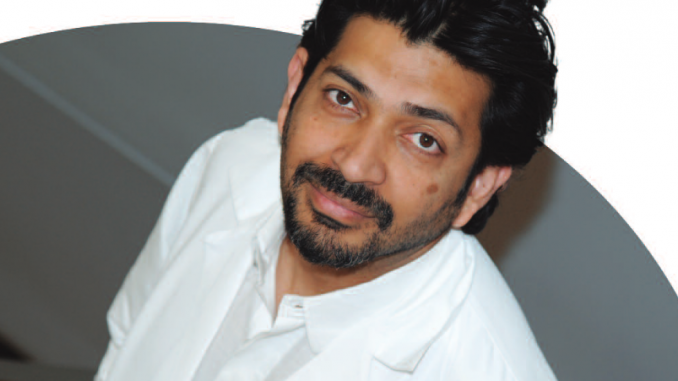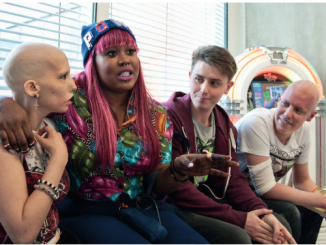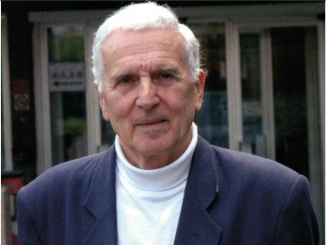
With our new-found understanding of cancer biology comes the opportunity to explain a disease that for centuries has confounded doctors and engendered stigma and superstition. Siddhartha Mukherjee took that opportunity and turned it into a best seller.
Just who is Siddhartha Mukherjee? This is the question many veterans of the cancer community asked as a book by this unknown author began to win critical accolades and prizes last year, including the Pulitzer Prize for non-Fiction and the Guardian First Book Award, earning Mukherjee a place among TIME magazine’s 100 most influential people.
Less than two years since publication, The Emperor of All Maladies: A Biography of Cancer has sold between half a million and a million copies, is being translated into 20 languages, and continues to generate around 50 emails to the author a day. “I was completely overwhelmed by the generosity of the response,” says Mukherjee, currently a practising oncologist specialising in haematological cancers at the Columbia University Medical Center in New York City. “By the size of it, by how diverse it is, by how diffuse it is. From students and general lay readers who said ‘I was never interested in this question till I read the book,’ to scientists at the National Institutes of Health who write thanking me for providing an overview. Different people come at it in different ways. For some people it gives them solace, for some it activates them. Young men and women write and say ‘I now want to be a scientist, a cancer researcher’. This happens literally every day.” His celebrity status is such that he was even approached by a group of students while on a trip with his kids to Disneyland.
Reading Mukherjee’s own biographical notes will tell you that he reached his current position as assistant professor of medicine at Columbia University, in charge of a translational research lab at the University’s Irving Cancer Research Center, through an academic research route, with the clinical practice coming only later. Born and educated in New Delhi, India, he went on to major in biology at Stanford University, California, where he worked in Nobel Laureate Paul Berg’s laboratory defining cellular genes that change the behaviours of cancer cells. A Rhodes Scholarship took him to Oxford, where he earned a DPhil in immunology. Only then did he train as an MD at Harvard Medical School, where he completed his residency in internal medicine followed by an oncology fellowship at Massachusetts General Hospital.
His research focuses on the links between normal stem cells and cancer cells, specifically probing the microenvironment of stem cells – particularly blood-forming stem cells. It has attracted grants from many sources including a coveted Challenge Grant from the National Institutes for Health, and generated papers published in journals including Nature, Neuron and the Journal of Clinical Investigation.
Mukherjee, then, could be summed up as one of the new generation of translational researchers who is exploring one of many interesting avenues that may offer new opportunities for intervening in processes that generate and fuel certain types of cancer growth.
None of this, however, offers a clue as to why he ended up being the first person to explain to a mass general readership the nature of this frightening, maddeningly elusive, multifaceted enemy that for millennia has had doctors, cancer patients and society at large asking: what is this thing we are up against?
For Mukherjee, however, the real question is why no one else had already done it. “When I was training as a fellow in cancer medicine what was amazing to me was that such a book didn’t exist. Here is a family of diseases that will affect one in two or three of us, and we don’t have a sense of what brought us to this point and what we might be doing next. So that is how the book began to be written. But my approach to this wasn’t to write a 600-page book. Really I began to keep a journal; it was a very personal journey for me to start with.”
It didn’t take him long to realise that his need to understand was shared, even more urgently, by many of his patients, and the book then also took on the task of trying to respond to their needs.
“Every time you treat a patient in the hospital, once you’ve allowed them to get used to the madness that modern medicine is, the first question patients want to know is: Why do I have this? What is going on? What do I do next? That is their first mechanism of grappling with the disease, long before diagnostic tests and therapeutics kick in.”
If people don’t get an answer they can make sense of, says Mukherjee, they reach out for other explanations, which can range from nihilism – cancer is too complex, too evasive; nothing can be done – to conspiracy theories. He recalls a talk he gave at a healing retreat for women with breast cancer, involving yoga and meditation, as “one of the most hostile environments” he has ever been in. “The conversation went like this: ‘Is it not obviously clear to you that there are abundant environmental carcinogens that you know and that I know are causing breast cancer? And if you know and I know, why have we not been able to change the world and remove these environmental carcinogens?’”
He often encounters patients who are convinced that pharmaceutical companies are hiding the real cure and are in cahoots with the government, or there are alternative therapies that will cure all cancers, but no one wants to invest in them and refine them. “These theories really abound across a swathe of this and other countries.”
Understandably, says Mukherjee, these perceptions corrode the relationship between doctors and patients that is so essential to practice medicine. “As I point out in my book, there is reason to be suspicious. The relationship has been corroded in the past. But I hope the book provides a perspective across the centuries about the complexity of the problem, how it has been tackled, correctly and incorrectly, what wrong roads we went down, and how we worked ourselves back.”
The challenge of explaining such complexities to a lay audience may be one reason why no one has attempted such a book before, and this one certainly does not lack ambition. It took Mukherjee seven years from start to finish and it is no ‘Idiot’s Guide’. Among its more scientific passages, for instance, is a highly accessible, but nonetheless demanding, description of the mechanism of retroviral transcription. But by that point in the book the reader has already been drawn into a dramatised history of the breakthroughs and false trails by which the true nature of cancer was being revealed, in fits and starts, glimpse by glimpse, through a diverse parade of protagonists from specialisms ranging from epidemiology to biology, pathology, surgery, haematology, internal medicine, radiology, virology and genetics.
These individual stories are woven together into a tragic-heroic detective story, an odyssey where the trail frequently diverts up blind alleys, led there by gifted, dedicated and courageous specialists who are often too certain of their own vision to pick up and interpret clues that should have turned them in another direction.
The surgeons who insisted for decades, and without evidence, that the only reason for recurrences and metastatic spread following breast cancer surgery must be that they had used too small a margin, and the only remedy was to chop out ever larger chunks of their patients’ upper torsos. The medical oncologists who, after the great initial breakthroughs using multidrug regimens to treat acute leukaemia and Hodgkin’s disease went on to apply the same principles to advanced breast cancer, treating up to 40,000 women with extremely toxic therapies before discovering that the only evidence of benefit was generated from a fraudulent trial in Johannesburg. The geneticists who discovered the structure of DNA, which was to prove such an important part of the puzzle, but insisted that Nixon’s proposed war against cancer would be a futile exercise until every last gene of the human genome had been decoded. The virologists whose discovery of the so-called “Rous sarcoma virus” in chickens lent credence to the theory that cancer is an infectious disease, leading to a fruitless decade of fevered searching for a single viral cause, which made little sense given the wider evidence.
Mukherjee describes his book as ‘a manifesto for humility’, and says he wanted to show that science doesn’t exist in “some kind of an Arcadian realm of perfect truth and honesty”, but is in fact a very human project, “and therefore susceptible to the same foibles that any human project is susceptible to: egos and mistakes and attachments to theories that then don’t get unattached from your brain.”
Every character in the book is real, he says, and shares the benefits, but also the paralysis, of being a visionary. “The vision becomes an obstruction. I made a point of trying to identify, to isolate, those moments in which the vision occurs and then the vision itself becomes a block. It’s true of most of the characters of this book. They have the simultaneity of human genius and human flaws. It became a story of human beings trying very hard, and sometimes failing very hard, to work their way around what is clearly one of the seminal problems of the 20th century.”
“I made a point of trying to identify moments in which the vision occurs and then the vision becomes a block”
The book is not without critics. Many researchers question the choice of what to include and what to leave out of the book. “The lodestone was anything that made a difference directly in the lives of patients,” says Mukherjee. “Someone asked me: What about telomeres? I said that is a very interesting theory and it will make itself into this book when you find me the first medicine that can modify telomeres in a real human being and make a difference in their lives. Even what about Avastin? If you were writing about macular degeneration, that book would have to have a central role for a drug like Avastin. But has Avastin really changed the way we think about and treat cancer? Not really. It was a wonderful theory, and then met the ugly facts. Does it make a huge difference? No. Not in breast cancer and barely in colorectal cancer.”
Mukherjee has also faced criticism for choosing to call the book a biography, on the grounds that it anthropomorphises cancer, attributing to it characteristics of an animate enemy rather than a biological phenomenon. “It’s created quite a backlash,” he says, “though there is no sentence in the book that does any of that except when quoting people talking about their illnesses in very human and personal terms.”
And while the book has certainly been widely welcomed by the oncology and science community, there may also be a hint of regret among some who were centre stage during many of the most exciting years, that this extraordinary tale of human endeavour ended up being told by someone who had not been there at the time. “My take on this is that you had to be a non-expert to write this book. It is crucial. You have to have the vulnerability to write without having to say you are the big expert.” He points out that many of the most moving and seminal books in medicine recently were written by people who are relatively young to the field. “Atul Gawande, writing in the New Yorker about surgical error, wrote that as a young resident in surgery, just after his fellowship, because he could see that world for what it was, with fresh eyes.”
“My take on this is that you had to be a non-expert to write this book. It is crucial.”
Ironically, perhaps, the book Mukherjee wrote as a ‘non-expert’ has propelled him onto the A-list of invitees to speak at countless seminars and conferences. Having outlined so elegantly the human obstacles to making progress, surely he can offer some solutions?
He does not duck the challenge. The big issue right now, says Mukherjee, is converting the tremendous gains of scientific research into human medicines. “The level of diversity that has been revealed even within one cancer let alone across cancers, and the level of evolutionary pressures that are operating in a single cancer cell would have left someone from the 1950s shocked. So we have all this knowledge, and the public is asking, and we are all asking: where are the medicines that come out of this knowledge?
“We have all this knowledge, and the public is asking: where are the medicines that come out of it?”
“I talk in the book about this metaphor that science inevitably produces a boil that lets itself out as steam through technology. But if you are living in the world of cancer, there is a lot of boil, especially from the basic science world, but there is little steam which would make the engine move. So the question we are asking ourselves is: Where is it? How can we transform breast cancer so that we can treat, say, triple negative breast cancer in a way that we could not even have imagined four or five years ago.”
One problem, he argues, is a lack of innovation from the pharmaceutical industry. “I’m waiting for good exemplars of this change in which the drug emerges from research performed primarily by biotech or pharma companies. I’ve yet to see that. The reality typically still remains investigator-initiated trials or protocols. The drug company possesses some IP [intellectual property rights] around a molecule and investigators around the world go to the company and say, look you have this molecule, allow us to test it in a particular disease. Then if there is something real there it catches fire. But the initiative still lies with the clinicians and translational researchers, even today.”
Comparisons that have been made with other industries with a similar focus on turning academic knowledge into marketable technologies – the IT industry for example – Mukherjee finds unilluminating. “It reduces the problem of cancer to a systems analysis and information systems problem, which it isn’t. It is vastly more complex.” And he doesn’t buy into the idea that progress is being strangled because commercial secrecy is tying up vital information. “It would be possibly if there were dozens of things out there to be secretive about. It’s not clear to me that we have that level of innovation yet. Pharma keeps telling us it has things up its sleeve that are deeply transformative. I haven’t seen them.”
He concedes, however, that these things can take time. “The claim is that a lot of innovation is going on within the pharma universe, but we can’t see it because by its very nature it’s hidden. Fair enough. Let’s say it happens in about a decade. The clock has just begun. We will find out if it is true or not.”
More and deeper understanding of cancer biology will of course continue to be important, but this is not where the blockage lies. What is needed now, says Mukherjee, is to bring more talented chemists into the field to help answer the question of how to intervene in the potential targets that have already been identified. He expects a strong contribution to this effort will come from the pool of expertise that is developing in India and China, among other emerging economies. “Hopefully they will bring a whole new wealth of ideas, chemical ideas.”
Ironically perhaps, the other area of expertise that Mukherjee argues is becoming increasingly important in developing new drugs comes from the traditional skills of the clinical practitioner. “You need better old medicine to understand new drugs. Your clinical skills have to be more astute than ever, because the variables have become so complex. That was not the case when you were giving cytotoxics. Now you are intervening on extremely specific aspects of human physiology and you need to know how to follow those.” He cites the example of the doctors who first began to notice a correlation between rash and response in the EGFR-inhibitor Erbitux (cetuximab). “You need a very astute physician to pick that up and say, ‘There is something here. This rash out of the hundreds of rashes that happen to people on chemotherapy, seems to have something to do with response.’ This has initiated a whole new field of understanding.”
The development path of the mTor inhibitor everolimus (Afinitor) is another good example, he says. “The phase I people who first tested the drug on patients with kidney cancer said ‘It’s not as if the drug were melting the tumour away, but we see these patients coming back, they feel better, they look better and their disease looks stable. There’s something there.’ In the old days of chemotherapy, you would say, ‘This is a nonsense intuition.’ This would be precisely the drug that you would discard.”
The BOLERO trial of Afinitor used in patients with advanced hormone-receptive breast cancer, who are resistant to endocrine therapy alone, is one of the few that Mukherjee admits could turn out to be ‘transformative’. Calling up a graph comparing progression-free survival between those on an endocrine inhibitor alone and those additionally given the mTor inhibitor, he puts his finger between the two curves. “It fits the famous ‘Bob Mayer rule’ [named after the eponymous Harvard professor at the Dana-Farber Cancer Institute]: if you can put a finger between the two arms it is real, if not you might as well discard it. We need more of these things that really make a big difference in survival.”
He is also excited about GlaxoSmithKline’s trial combining BRAF therapy with immunological therapy against melanoma. “This is an obvious idea, seeing what will happen if you can combine targeted therapy and micro-environment-directed therapy or immunology-directed therapy. Presumably the immunology-directed therapy will have completely different pathways and be non-redundant with targeted therapies that are autonomous to the cancer cell. This is the kind of stuff that really excites me.”
Remembering the lessons of his own book, however, Mukherjee is careful not to get too carried away. As he says, the reality is that there are more women who have been cured or benefited from “boring old chemotherapy” for early breast cancer than any targeted therapy for any cancer. “The question is: where are we going? Have we made another mistake? Are we wrong in thinking that the way forward is to target the cancer cell? Maybe five years from now we will conclude that this is not the best way to go. But you cannot go somewhere else without being here now.”
Remembering the lessons of his own book, Mukherjee is careful not to get too carried away
Mukherjee himself seems to accept no limits on his intellectual curiosity. In mid April the New York Times magazine carried a feature piece he wrote on the science and history of treating depression, titled ‘Post-Prozac Nation’, where he applies his detective writing skills to trying to make sense of another journey of scientific discovery that has been marked by great hopes of a magic bullet followed by disappointment, conspiracy theories and distrust.
At the same time, he has taken great care to sustain his hands-on clinical practice, though this has been tricky in the wake of his new-found fame, to the extent that he finds it very hard to keep his clinical and research agenda on track. Overloaded with requests from people wanting second, third, fourth or even fifth referrals, he took a pragmatic decision to remove that pressure. While he takes his turn caring for patients on the ward, he has moved his entire clinical practice to the ‘fellows’ clinic’, which is run for people with no medical insurance and often no proper legal status. “Not because I’m a saint,” he hastens to add, “but because it wipes the slate clean of all the access issues.”
Mukherjee does not encourage discussion of his background or family, though the wide use of literary allusions and the general accessibility of the structure and style of his writing has, rightly or wrongly, been at least partially credited to the influence of his artist wife Sarah Sze, and he clearly revels in intellectual stimulus from almost any direction. He talks of himself as having multiple lives, “or at least dual lives,” centred around patients. “Every time I think about anything that is relevant, for instance trying to understand how we ended up with this hypothesis of depression in 2012, and what the next steps are, I go back to patients. So this life is very important for me. It keeps me alive and it keeps my brain alive in a way I have to protect, otherwise I cannot keep working on other more abstract things.”






Leave a Reply